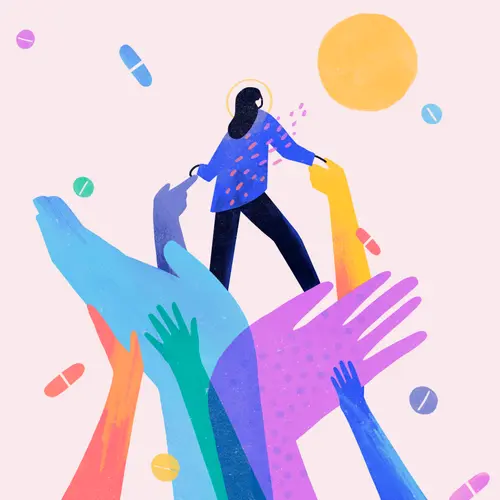The sexuality spectrum refers to the idea that people’s sexual identities and orientations are complex and resist easy classification. Instead of offering people a choice between either homosexual or heterosexual -- or even a choice between homosexual, heterosexual, or bisexual -- it provides a way of talking about sexuality along in terms of many possibilities.
The sexuality spectrum also allows for greater fluidity of sexual identity and expression. You might change from one position to another or move about the spectrum. Large-scale studies have supported both the idea that broad terms can be misleading for some people and that people often have sexual orientation ranges rather than fixed orientations.
To some extent, the shift from categories or sexuality to a sexuality spectrum is a generational shift. Millennials increasingly prefer to identify themselves along a spectrum. However, the spectrum is neither a specifically millennial phenomenon nor a concept embraced by all millennials.
Different Sexual Orientation Spectrums
The spectrum itself isn’t a singular entity. Instead of one line with complete homosexuality at one end and complete heterosexuality at the other, there are more than 200 scales people have developed to define sexuality.
The three most commonly used scales are the following:
The Kinsey Scale
In 1948, Dr. Alfred Kinsey and his research partners published Sexual Behavior in the Human Male, the first landmark study to suggest that people didn’t fit exclusively into the categories homosexual and heterosexual. Kinsey proposed a scale from zero to seven, with zero being exclusively heterosexual and seven being exclusively homosexual:
- Only heterosexual
- Mostly heterosexual, sometimes homosexual
- Mostly heterosexual, but more than sometimes homosexual
- Equally heterosexual and homosexual
- Mostly homosexual, but more than sometimes heterosexual
- Mostly homosexual, only sometimes heterosexual
- Only homosexual
Kinsey also provided for an additional category: X, no socio-sexual contacts or reactions.
The Klein Sexual Orientation Grid
In 1978, Fritz Klein published The Bisexual Option. In it, he outlines a grid that asks people to rate seven aspects of sexual orientation/identity from one to seven, with one being other sex/heterosexual only and seven being same sex/homosexual only. The seven aspects are:
- Sexual attraction
- Sexual behavior
- Sexual fantasies
- Emotional preference
- Social preference
- Heterosexual/homosexual lifestyle
- Self identification
People are asked to rate each of these aspects for three categories: past, present, and ideal.
Storms Sexuality Axis
In 1981, Michael Storms wanted to better incorporate asexuality and differentiate it from bisexuality in sexuality models. He theorized that sexuality was better discussed with respect to x and y axes, with the x axis corresponding to homosexuality and the y to heterosexuality. A zero value along either axis would correspond to no orientation in that direction, and zero values along both axes would indicate total asexuality.
All three of these models have been critiqued and supplemented in different ways, but they show a variety of ways of thinking about sexual orientation as occurring along a spectrum. They are tools for understanding. Different people find different models most helpful when it comes to articulating their own sexuality.
Other things can play a role in spectrum sexuality. Kink, fetish, and bondage, dominance, sadism and masochism (BDSM) activity can also be defined along spectrums and can play a role in intersectional sexual identities, identities that occur at the crossroads of a number of different aspects of human sexuality.
The Asexuality Spectrum
Asexuality can also be described along a spectrum. Many people have more complicated relationships with sexual desire than an asexual/sexual binary allows.
Asexuals and aromantics were the first to develop the Split Attraction Model, which can be applied outside of the asexuality spectrum as well. The Split Attraction Model proposes that for every sexual orientation/expression, there’s also a romantic counterpart. For example, some may enjoy a certain type of romantic relationship or experience but not wish to take it into a sexual arena.
Possibilities on the asexuality spectrum include:
Asexual
You don’t experience sexual attraction to other people. Even within this one category, there’s a range of individual expressions and experiences. For example, some may not experience direct sexual attraction but may enjoy the act of sex. Others may be repulsed by the idea of sexual contact. Still others might enjoy solo sexual activities such as masturbation. You may see the contraction “ace” used as a label for asexual individuals.
Aromantic
People in this group don’t experience romantic attraction. As with asexuality, aromanticism can come in a variety of forms.
Gray-Asexual (Graysexual)/Grayromantic
These terms apply to people who fall somewhere between asexual or aromantic and sexual or romantic. They’re incredibly broad, and people who identify by one of the following terms may also identify as graysexual or grayromantic.
Demisexual/Demiromantic
Demi individuals don’t experience initial sexual or romantic attraction to people. However, as time passes and relationships develop, sexual or romantic feelings may develop.
Reciprosexual/Recipromantic
You only experience attraction to someone after knowing they’re attracted to you.
Akoisexual/Akoiromantic
You experience sexual or romantic attraction, but it goes away once you learn they’re attracted to you, too. Other names for this group include akoinesexual/akoineromantic and lithsexual/lithromantic.
Aceflux/Aroflux
You move around within the asexuality spectrum or may even move outside of it at some points.

